If not designed and installed properly, wiring inside cable trays may pose hazards such as fire, electric shock, and arc-flash blast events.
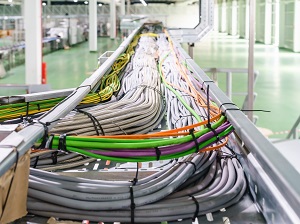
Cable trays can be part of a planned cable management system to support, route, protect, and provide a pathway for cable systems. Power, low voltage control, data, or telecommunications wiring distribution systems can be used with cable trays.
When used correctly, cable trays can make it easier to mark, remove, and find cables when needed. Cable trays are a good choice for installations that may require future upgrading, reconfiguring, or relocation.
During the maintenance, installation, and inspection of cable trays, appropriate safety precautions must be taken into consideration.

Cable trays, the conductors, and cables they contain, and the wiring methods used must be listed or labeled by a Nationally Recognized Testing Laboratory (NRTL) as suitable in the environment in which they are installed.
Cable trays are available in a variety of configurations and must be properly supported in accordance with the installation instructions. Cable trays should be designed and installed to meet current requirements and anticipate future needs.
OSHA Standard 1910.303(b)(8)(i) Electric equipment shall be firmly secured to the surface on which it is mounted.
The type and number of cable trays, and the support required to handle loads must take into account several factors, including, but not limited to:
- Environmental or weather factors
- The weight of the cable tray
- Current and future cable needs
- Electromagnetic forces
- Any accessories installed
Securing cables within the cable trays is important to maintain proper spacing between cables, keep the cables inside the trays, and confine the cables to specific locations within the trays.
Cable ties should be appropriate for the conditions in which they are used. When selecting cable ties, consider relevant factors like length, temperature, moisture resistance, ultraviolet resistance, chemical resistance, flammability, low smoke characteristics, and strength.
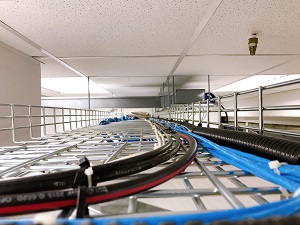
Since cable trays come in a wide variety of sizes, they can be designed to accommodate a wide range of loading configurations, but because of their flexibility, cable trays are especially subject to overloading.
Safe and permissible loading of cable trays is governed by three criteria:
- manufacturer-specified weight restrictions
- limitations of cable fill because of cross-sectional area limitation
- conductor spacing requirements
Overloading cable trays can lead to a breakdown of the tray, its connecting points or supports, causing hazards to persons underneath the cable tray and even leading to possible electric shock and arc-flash/blast events from component failure when the cables are suddenly no longer supported.
When cable trays are overloaded, excessive heat build-up in and around live conductors can cause the insulation to break down, leading to potential shock hazards or fires.
When cable trays become overfilled, add another cable tray system above, below, or next to the overfilled tray. Allow enough working space around the added cable tray.
Abandoned cables within cable trays should be removed. Temporary wiring installed within cable trays should be removed upon the completion of projects.
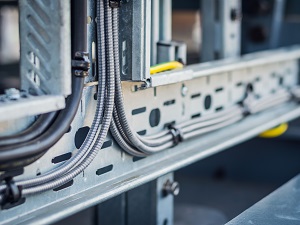
Use of cable trays is popular in hazardous locations where concentrations of flammable or combustible gases, vapors, and dusts exist, but care must be taken during installation to not introduce an explosion hazard. Cable trays in hazardous locations must only contain the wiring permitted in such locations.
OSHA Standard 1910.305(a)(3)(iv) Cable trays in hazardous (classified) locations may contain only the cable types permitted in such locations. Reference OSHA Standard 1910.307.
Cable trays can be rated for:
- Indoors or Outdoors
- Corrosive and Classified Hazardous Locations
- Areas with High Electrical Noise and Vibration
Cable trays may be designed to cross through walls and partitions, as well as vertically through floors or platforms.
OSHA Standard 1910.305(a)(3)(v) Cable tray systems may not be used in hoistways or where subjected to severe physical damage.
Where cable trays pass through fire-rated partitions, walls, and floors, appropriate fire-stops should be provided to prevent the spread of a fire or the by-products of combustion. Cable trays should not be installed in any passageways where they could be damaged.
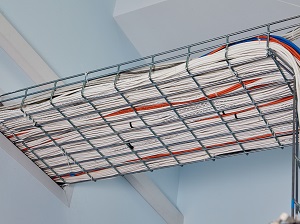
Cables and conductors approved for use in cable trays are required to be insulated, but additional measures may be required for safety.
If work being performed on cable tray installations may expose workers to live parts or could damage the insulation, then the wiring must be de-energized.
OSHA Standard 1910.333(a)(1) Live parts to which an employee may be exposed shall be deenergized before the employee works on or near them, unless the employer can demonstrate that deenergizing introduces additional or increased hazards or is infeasible due to equipment design or operational limitations.
Grounding of cable tray systems is essential for personal safety and protection against arcing that can occur anywhere in the wiring system.
Aluminum, steel, and coated-steel cable trays, all being metallic, may be used as equipment grounding conductors. Metallic cable trays may be used as equipment grounding conductors only where continuous maintenance and supervision ensure that qualified persons will service the installed cable tray system.
Proper grounding must be done before cables are installed and tested before cables are energized.
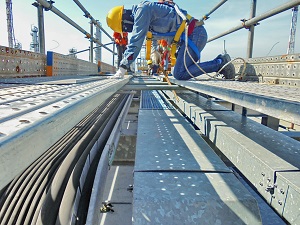
FOR MORE INFORMATION ON CABLE TRAYS
The use and installation of cable trays is covered by Article 392 of the National Electrical Code (NEC), and by OSHA standards 1910.305(a)(3) and 1910.399, or comparable standards in OSHA-approved State plans.
The National Electrical Manufacturers Association (NEMA) publishes three standards that apply to the proper manufacture and installation of cable trays including
- ANSI/NEMA-VE 1-1998, Metal Cable Tray Systems
- NEMA-VE 2-1996, Metal Cable Tray Installation Guidelines
- NEMA-FG-1998, Nonmetallic Cable Tray Systems
For more information visit the Cable Tray Institute at cabletrays.org.
Always consult the Cable Tray Manufacturer’s Installation and Use Instructions.

.jpg)

